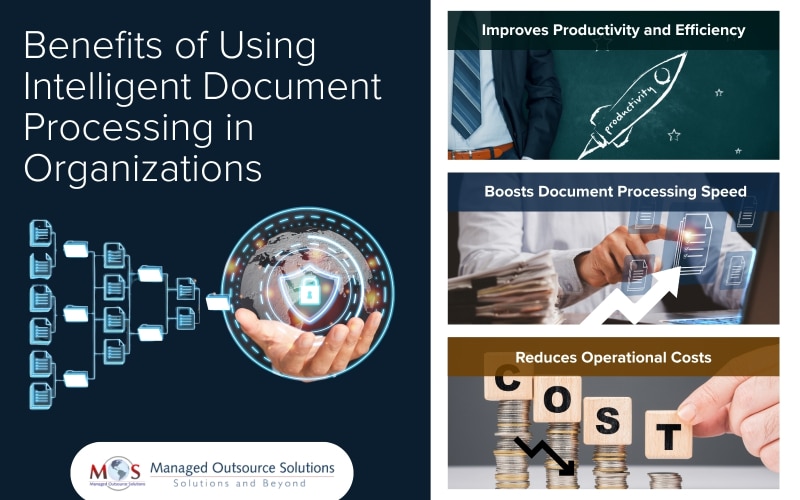A significant portion of today’s data comprises business-related information, which includes both personal and organizational records stored in various electronic or physical formats. The challenge lies in the fact that much of this data, whether related to employees, customers, vendors, or other entities, exists in unstructured formats such as PDFs, images, emails, and text documents.
Document conversion services play a crucial role in addressing this issue by digitizing and transforming unstructured files into searchable, well-organized electronic formats. Advancements like Intelligent Document Processing (IDP) have further revolutionized this process by leveraging cutting-edge data extraction technology such as Natural Language Processing (NLP), Computer Vision, Optical Character Recognition (OCR), and Machine Learning (ML) to accurately capture, extract, and process data from diverse document types.
What is Intelligent Document Processing?
IDP is an advanced technology that captures, extracts, and organizes data from various documents, enabling seamless business process automation and improved operational efficiency. Digital transformation in businesses is being fueled by IDP solutions that streamline document handling and improve operational efficiency.
Initially, IDP was primarily used in back-office operations, such as invoice processing, and other routine document management tasks, but it has since expanded to front-office functions and complex workflows across industries. IDP technology advanced significantly over time, integrating sophisticated capabilities such as Natural Language Processing (NLP).
This advancement allows systems to move beyond basic character recognition, enabling them to interpret the meaning of words, phrases, and sentences within a document. Modern IDP solutions not only extract data but also redefine how information supports customer and employee experiences.
How does IDP Work?
Intelligent document processing operates through a series of well-defined stages that transform data from paper-based or digital documents into structured, actionable information. Each stage plays a crucial role in ensuring that the extracted data is accurate, contextually relevant, and ready for use across business processes.
- Document Preprocessing
The process begins with enhancing the quality of input documents. Techniques such as noise reduction, binarization, and de-skewing are applied to clean and optimize scanned or digital files, ensuring they are ready for accurate data extraction.
- Text Extraction
Next, OCR and related technologies are used to detect and extract text from documents, regardless of format or layout. This step converts visual information into machine-readable data.
- Data Understanding with NLP
Once the text is extracted, NLP interprets and contextualizes the content, helping the system understand the meaning, intent, and relationships within the data. This enables deeper insights rather than just surface-level recognition.
- Data Validation
The extracted information then undergoes validation to ensure its accuracy, consistency, and reliability. This stage may involve cross-referencing data with predefined business rules or databases to detect and correct errors.
- System Integration
Finally, the validated and structured data is seamlessly integrated into downstream systems and workflows, such as ERP, CRM, or document management solutions. This ensures that information flows efficiently across departments, supporting automation, decision-making, and overall business productivity.
By combining AI, OCR, and NLP technologies, IDP transforms raw, unstructured data into valuable business intelligence that enhances accuracy, speed, and operational efficiency.
Uses of Intelligent Document Processing in Different Industries
- Insurance: In the insurance sector, IDP is revolutionizing claims management and customer service. It automates routine claims, enables digital self-service options, and frees employees to focus on personalized support.
For instance, global insurance broker Ecclesia Group used IDP to automate data extraction from claims, match documents to the right customers, and route them to claims managers, drastically improving turnaround time and accuracy.
- Banking and Financial Services: IDP simplifies complex processes like customer onboarding, KYC compliance, and loan processing.
In mortgage applications, for example, it automatically extracts and validates data from hundreds of pages—speeding up approvals and enhancing the customer experience. Spanish automation company Serimag leveraged IDP to process millions of loan applications during the pandemic, achieving 75% automation and 99% accuracy in just six weeks. This highlights the power of Intelligent Document Processing for data accuracy and compliance, ensuring faster service and regulatory adherence.
- Healthcare: Healthcare organizations use IDP to streamline administrative workflows, improve revenue cycle management, and support data-driven decisions.
The U.S. Food and Drug Administration employed IDP to accelerate adverse event report processing, achieving 99% accuracy and ensuring faster responses to protect public health.
- Transportation and Logistics: In logistics, IDP minimizes documentation errors that can delay shipments. It automates the processing of customs forms, delivery receipts, and invoices, ensuring accuracy and timely operations. Deutsche Post DHL Group adopted IDP to process multilingual invoices from over 120 vendors, reducing manual work and achieving a 70% boost in overall efficiency.
Benefits of using Intelligent Document Processing in Organizations
- Improves Productivity and Efficiency: Manual document processing processes are time consuming and error-prone. Reports indicate that the error rate of standard invoice processing is 10% (www.docacquire.com).
For banks and insurance agencies, which handle huge volumes of documents, manual processing of data is costly and risk prone. Digitization through IDP greatly increases the speed at which documents are processed and improves productivity and efficiency. Automating the loan application process has greatly helped to meet the unprecedented demand.
- Boosts Document Processing Speed: Manually digitizing PDFs is an extremely challenging task as a PDF form has about 50 form fields. Forbes reports how Dropbox company HelloSign resolved the challenges of manually digitizing PDFs by introducing HelloWorks, a product that automatically converts PDFs documents into mobile friendly forms, saving customers a lot of valuable time.
- Reduces Costs: According to infrrd.ai, IDP significantly reduces the costs of processing large volumes of data, that is, there is a 20%-50% reduction in cost per document processed. It is reported that IDP saved a financial services company by cutting staff needed for manual data extraction by 50%.
Documents are the foundation of every business and extracting valuable data from them is critical for businesses to make informed decisions. Document scanning services serve as the first step in Intelligent Document Processing (IDP), converting physical papers into digital formats that can be automatically extracted, classified, and processed for faster, more accurate workflows.
Recent reports highlight the growing importance of IDP for enterprise intelligence, the role of document intelligence in transforming data, the integration of generative AI into IDP platforms for enhanced automation, and the acquisition of IDP-focused companies. Future IDP systems will use AI to read and process documents more intelligently while leveraging blockchain for authenticity and protection.





